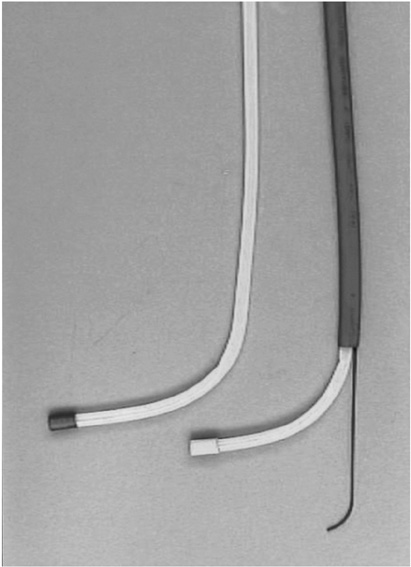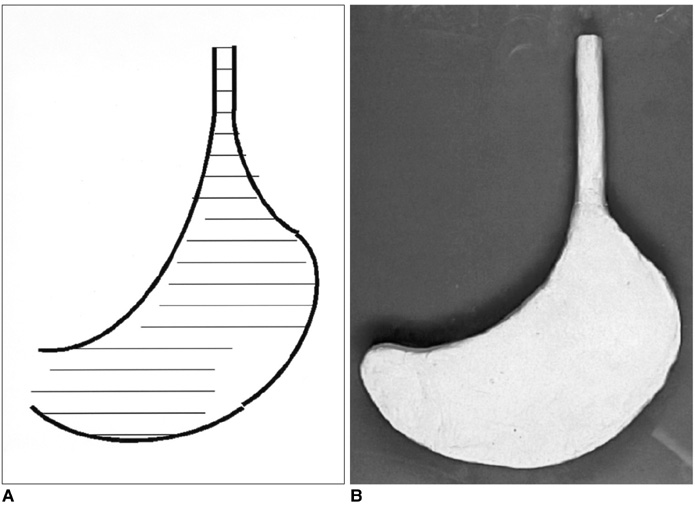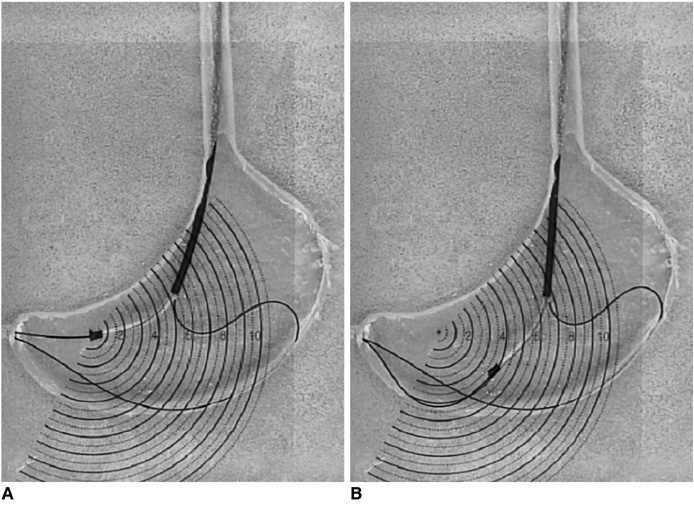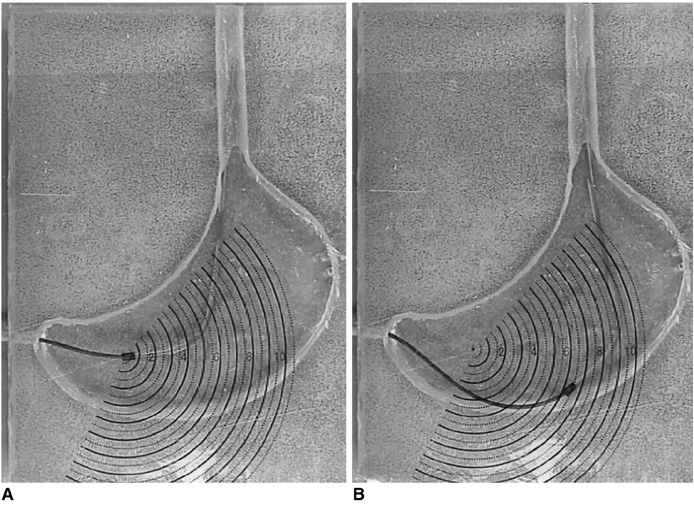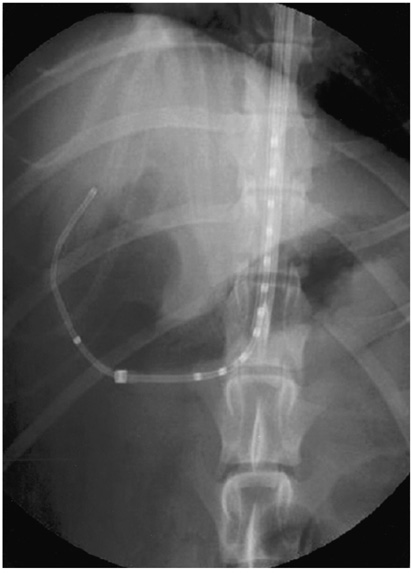Korean J Radiol.
2004 Jun;5(2):114-120. 10.3348/kjr.2004.5.2.114.
Newly Designed Sheaths for Gastroduodenal Intervention: An Experimental Study in a Phantom and Dogs
- Affiliations
-
- 1Department of Radiology Asan Medical Center, University of Ulsan College of Medicine. hysong@www.amc.seoul.kr
- 2Department of Radiology, Gachon Medical School, Gil Medical Center.
- 3Department of Biomedical Engineering, Asan Medical Center, University of Ulsan College of Medicine.
- KMID: 753991
- DOI: http://doi.org/10.3348/kjr.2004.5.2.114
Abstract
OBJECTIVE
To evaluate the usefulness of newly designed sheaths for gastroduodenal intervention in a gastric phantom and dogs. MATERIALS AND METHODS: A regular sheath was made using a polytetrafluoroethylene tube (4 mm in diameter, 90 cm long) with a bent tip (4 cm long, 100 degree angle). For the supported type of sheath, a 5 Fr catheter was attached to a regular sheath to act as a side lumen. To evaluate their supportability, we measured the distance of movement of the sheath's tip within a silicone gastric phantom for three types of sheath, the regular type, supported type, and supported type with a supporting guide wire. The experiments were repeated 30 times, and the results were analyzed using ANOVA with the postHoc test. In addition, an animal experiment was performed in six mongrel dogs (total: 12 sessions) to evaluate the torque and supportability of the sheaths in the stomach, while pushing a guide wire or coil catheter under fluoroscopic guidance. RESULTS: In the guide wire application, the distances of movement of the sheath tip in the three types of sheath, the regular type, supported type, and supported type with supporting guide wire, were 8.40+/-0.51 cm, 6.23+/-0.41 cm, and 4.47+/-0.32 cm, respectively (p < 0.001). In the coil catheter application, the corresponding values were 7.22+/-0.70 cm, 5.61+/-0.31 cm and 3.91+/-0.59 cm, respectively (p < 0.001). All three types of sheath rotated smoothly and enabled both the wires and catheters to be guided toward the pylorus of the dog in all cases. CONCLUSION: The newly designed sheaths can be useful for gastroduodenal intervention.
MeSH Terms
Figure
Reference
-
1. Lindor KD, Ott BJ, Hughes RW Jr. Balloon dilatation of upper digestive tract strictures. Gastroenterology. 1985. 89:545–548.2. Jung GS, Song HY, Kang SG, et al. Malignant gastroduodenal obstructions: treatment by means of a covered expandable metallic stent-initial experience. Radiology. 2000. 216:758–763.3. Song HY, Yang DH, Kuh JH, Choi KC. Obstructing cancer of the gastric antrum: palliative treatment with covered metallic stents. Radiology. 1993. 187:357–358.4. Mauro MA, Koehler RE, Baron TH. Advances in gastrointestinal intervention: the treatment of gastroduodenal and colorectal obstructions with metallic stents. Radiology. 2000. 215:659–669.5. Pinto IT. Malignant gastric and duodenal stenosis: palliation by peroral implantation of a self-expanding metallic stent. Cardiovasc Intervent Radiol. 1997. 20:431–434.6. McLean GK, Meranze SG. Interventional radiologic management of enteric strictures. Radiology. 1989. 170:1049–1053.7. McLean GK, Cooper GS, Hartz WH, Burke DR, Meranze SG. Radiologically guided balloon dilation of gastrointestinal strictures. Part I. Technique and factors influencing procedural success. Radiology. 1987. 165:35–40.8. McLean GK, Cooper GS, Hartz WH, Burke DR, Meranze SG. Radiologically guided balloon dilation of gastrointestinal strictures. Part II. Results of long-term follow-up. Radiology. 1987. 165:41–43.9. Holt PD, de Lange EE, Shaffer HA Jr. Strictures after gastric surgery: treatment with fluoroscopically guided balloon dilatation. AJR Am J Roentgenol. 1995. 164:895–899.10. Hegedus V, Raaschou HO. Radiologically guided dilatation of stenotic gastroduodenal anastomosis. Gastrointest Radiol. 1986. 11:27–29.11. Kozarek RA. Hydrostatic balloon dilation of gastrointestinal stenoses: a national survey. Gastrointest Endosc. 1986. 32:15–19.12. de Baere T, Harry G, Ducreux M, et al. Self-expanding metallic stents as palliative treatment of malignant gastroduodenal stenosis. AJR Am J Roentgenol. 1997. 169:1079–1083.13. Shin JH, He X, Lee JH, et al. Newly designed multifunctional coil catheter for gastrointestinal intervention: feasibility determined by experimental study in dogs. Invest Radiol. 2003. 38:796–801.14. Binkert CA, Jost R, Steiner A, Zollikofer CL. Benign and malignant stenoses of the stomach and duodenum: treatment with self-expanding metallic endoprostheses. Radiology. 1996. 199:335–338.
- Full Text Links
- Actions
-
Cited
- CITED
-
- Close
- Share
- Similar articles
-
- Balloon Sheaths for Gastrointestinal Guidance and Access: A Preliminary Phantom Study
- Understanding the Rome IV: Gastroduodenal Disorders
- The effect of newly designed toothbrush on plaque control, treatment of gingivitis and periodontitis
- Development of gastroduodenal self-expandable metallic stents: 30 years of trial and error
- Design of Multipurpose Phantom for External Audit on Radiotherapy

